Genre: Platformer Developer: Taito Publisher: Taito Players: 1 Released: 1990
Growing up, I was always at the local arcade. Whether it was to trekking across town on a Sunday with my brother to play Donkey Kong or spending my weekends at Circus Playhouse perfecting my Super Mario Bros. runs, I was always there. I was lucky enough to live within walking distance of a mall that had a Bally’s Aladdin’s Castle right across the street from Circus Playhouse, and it complemented that great pizza arcade palace’s collection of older and odder arcade titles with a grand selection of the newest machines. It was there that I spent many a summer blowing cash on classics like Kung-Fu Master and Gauntlet, but I often crossed the highway to play Star Castle and Sega’s SubRoc 3D. Circus Playhouse always kept its machines in great condition, and one could always find something new among its more than two hundred games.
Taito was heavily represented there, and I was able to pump quarters into Qix, Gladiator and lots of other great games. Platformers were a big theme in the ’80s, with Mario leading the charge, but there was one title that stood out among the rest. It was a game that lured players in with its cutesy graphics and catchy music, only to crush their souls with its brutal difficulty. That game was New Zealand Story. To this day I have yet to finish it, but I keep coming back to try. I’m enthralled by its saccharine aura and intuitive gameplay, and while it pains me to see those little kiwis suffer, I never give up!
At first glance, there’s nothing that seems to distinguish New Zealand Story from the plethora of other platformers available at the time. As a little Kiwi out to save his friends from Wally the Walrus, Tiki navigates huge stages, kills enemies and grabs power-ups, and fights large bosses. Standard fare to be sure, but Taito somehow managed to nail the atmosphere that many other titles in the genre lack, and it created a world that continually keeps players coming back for more. Atmosphere is a big part of Super Mario Bros.’s charm, and the developers at Taito knew that. They filled Tiki’s world with bright, charming colors and patterns, building an almost daycare center-like environment that has players injecting a sincere “aww” between grunts of fury and frustration.
Don’t get me wrong; it’s the good kind of frustration, the challenging kind. New Zealand Story has a challenge level on par with classics like Ghouls ‘N Ghosts, and it is quite unforgiving. The key to success, as with most games of this caliber, is to learn enemy locations and patterns. Rote memorization is the only path to success, and good players undoubtedly had crowds around them while they schooled their friends with their platforming mastery. NZS offers that kind of satisfaction, but the path to brilliance is one filled with arrows, balloons, and lots and lots of dead kiwis.
Even against such overwhelming odds, Tiki has a lot on his side. There are lots of cool rides like balloons and teddy bear heads (laser-firing saucers are my favorite), and each vehicle has its own advantages. There are those that are weak but very fast and others that are slow but impervious to enemy fire. Moreover, Tiki’s simple bow and arrow can be upgraded with bombs, lasers, and even fire balls. This provides some awesome firepower that, along with taking things slow, can mean the difference between beating a stage and starting over.
The difficulty stems from NZS’s one-hit kills. The only protection afforded is by a balloon or other vehicle, and those only allow one hit. If Tiki is on his own, ANYTHING will kill him instantly – enemies, projectiles, spikes – you name it, it kills him. I think he moves a bit too slowly for such a delicate little bird, and his low speed is primarily what makes the game so challenging. The bosses are especially relentless, because many of them have difficult patterns (shooting from off-screen?) and take a lot of hits to kill. Free lives can only be obtained by spelling “EXTEND” and players will go through many more kiwis than it may be worth to get that elusive extra. Scrub that I am, I eagerly use the ninety-nine lives code for the Game Genie, and there’s an invincibility one as well, though it only works after losing a life and not at all with bosses. Even with these added tools, the game is still incredibly difficult.
In truth, no one would ever think that such an adorable adventure could be so hard. Taito was especially sadistic with the level design, making the four zones (each with four stages and a boss) convoluted enough that players can get lost even with arrows pointing the way. Luckily, there are checkpoints, so losing a balloon and falling to a spikey death doesn’t mean starting completely over. Furthermore, sticking around too long on a level attracts a clock-wearing demon who hunts Tiki with Terminator efficiency.
That’s the whole paradox with NZS. The game looks so cute, with its colorful visuals and hummable theme song. Few of the enemies actually look threatening, and everything just looks so safe. The visuals may not be on par with other Genesis titles already available at the time, and there is an unfortunate lack of parallax scrolling. However, it approximates the arcade original well enough, and the colors and details are very appealing. I doubt anyone will focus on the graphics once the reality of the gameplay sets in, and all that sweet cuteness will melt away like a face in Raider of the Lost Ark.
I have to say that despite its high difficulty level and mediocre graphics, New Zealand Story is still a fun game to play. It’s one of those adventures that challenges the player’s resolve and happily goes toe-to-toe with anyone brave enough to grab a controller. Most of the time, the Kiwis lose, but there’s a sort of masochistic sense of accomplishment with the completion of each level. Copies are relatively inexpensive, and players looking for another Herculean task need look no further. I’ll most likely never finish it, but I can’t say it hasn’t been fun trying.
SCORE: 6 out of 10


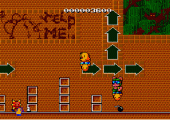
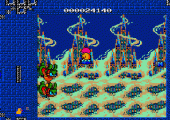
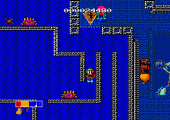
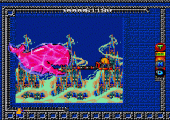
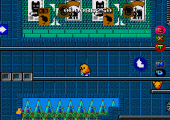
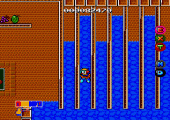
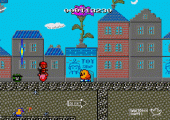
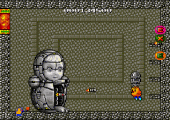
Recent Comments